Combat aircraft. A difficult choice for the designer Ilyushin
Another reflection inspired by readers' questions. What is IL-10 and how much was it needed by the Red Army Air Force, given the presence of IL-2, "flying tank" etc?
Here we must immediately say that new aircraft in our Air Force after 22.06.1941/5/3 were a huge rarity. Actually, there were only three of them. La-2, which was radically altered LaGG-10, Tu-XNUMX, about which we can say that it was “from scratch” constructed, and IL-XNUMX.
And around the latter, there is still a rather heated debate about what it is: the modernization of the IL-2 or a new aircraft. There are enough arguments for both versions.
Let's watch. As always - in history.
And history has preserved a bunch of documents for us (for example, order by the NKAP No. 414 of July 12, 1943), which indicates that back in 1943 Ilyushin was ordered a certain Il-1 aircraft with an AM-42 engine. And this plane was supposed to be made by factory number 18 to 15.09.1943/2/XNUMX. But it did not work out due to the workload of the plant with the release of IL-XNUMX.
According to GKO Decree No. 4427 of October 26, 1943, Ilyushin was to submit TWO cars for state tests no later than October 15.10, 1943. Single and double.
Why is that?
Because the courtyard was the end of 1943. And the Soviet aviation slowly but surely, overcoming the heroism of the German "aces" such as Hartmann, who shot down hundreds and thousands of aircraft, gained an advantage in the air.
What does an advantage mean? This means that the nine IL-2, on which the eight of Me.109 has focused, was covered not by a couple of four fighters, but by a minimum of 6-8. From here, the hartmans ceased to cope with the total annihilation of the Soviet Air Force, which directly (unpleasant) was reflected in the ground forces.
If we had so many planes that it became difficult for the Germans to get our attack planes, accordingly, we thought about such a maneuver: to strengthen the pilot's armor protection from fire from the rear hemisphere and remove the arrow.
The practice of 1941-43 showed that it is not so useful, comrade "back to front." According to the statistics of the attack air regiments of the 8th and 17th air armies during the period 1943-45, the average ammunition consumption of the UBT machine gun in one Il-2 combat sortie was 22 rounds, which corresponds to a firing duration of only 1,32 seconds.
It is clear that this average is very approximate, that is, someone could not shoot at the enemy because of his absence in 1945, and someone in 1943 landed the entire ammunition from flight to flight. But in general, the statistics for the hospital are as follows.
Move on. There is one more figure. The probability of a shooter being struck by German fighter fire was 2–2,5 times higher than the probability that the attack aircraft would be shot down by the same fire.
At the same time, the probability of victory in a duel between a German pilot and a Soviet shooter was estimated as 4-4,5 in favor of the German.
That is, for one IL-2 shot down by German fighters, there were a minimum of 3-4 killed or wounded gunners. Usually slain. The Germans had gauges in the second half of the war that there was no doubt about that: 13 mm, 15 mm, 20 mm, 30 mm. And with the arrow protection of the shooter there were such nuances that he simply did not leave any chances.
No wonder that in conditions of good fighter cover, pilots began to fly without gunners. There were such people as an example I can give the Hero of the Soviet Union pilot-cosmonaut Georgy Beregovoy, who was noted in such flights.
That is why in 1943 they returned to the project of a single-seat attack aircraft. On the whole, it’s not in vain, because no matter how they called the position of the gunner on the IL-2, even a “sentence”. Losses among the shooters were indeed quite large.
Alas, the circumstances were such that it became clear: two aircraft plant No. 18 will not be able to master. Nobody withdrew obligations on the construction of IL-2 from the plant, and each skilled worker was on the bill.
Sergey Ilyushin faced a difficult choice. Obviously, one of the two aircraft had to be abandoned. Only the chief designer could make a choice which aircraft to leave. That's why he is the main one. Ilyushin chose to leave the two-seater plane, about which he wrote in a letter to the Narcotics Aviation Shakhurin.
Why he did just that will become clear a little later.
The machine should have had the following characteristics:
- maximum speed at the ground - 445 km / h;
- at an altitude of 2000 m - 450 km / h;
- the longest flight range with normal take-off weight - 900 km;
- normal bomb load - 400 kg (overload - 600 kg);
- armament, consisting of two VY cannons with an ammunition of 300 rounds, two ShKAS machine guns with an ammunition of 1500 rounds and one 12,7-mm machine gun of M.E. Berezin UBC with 150 rounds of ammunition.
Now many will say: and how is this aircraft different from the IL-2? Besides a bit more speed and increased ammunition for ShKAS?
These were preliminary requests. Of course, the AM-42, which had 200 horsepower more than the AM-38, could allow other improvements.
I will say a few words in the direction of a single-seat attack aircraft.
In principle, if you reduce the armored capsule, remove the machine gun, arrow, ammunition, it turns out that the plane could lose in weight from 600 to 800 kg. It's a lot. If converted to fuel, the range could increase by 300 km, or increase the bomb load, bringing it to 1000 kg.
Or there was an opportunity to strengthen the supporting structures and thereby provided the possibility of a steep dive. That is, in fact, it turned out a well-armored attack bomber capable of bombing from a dive. This would be a very serious help for attacking ground units.
A project of such an aircraft existed. It was an IL-8, option number 2. However, the development of the IL-8 is worth a special discussion, the fact that it was possible to create such an aircraft.
But in 1943, a new plane did not work. Try to guess the reason? That's right, engine. This is an eternal problem, and the AM-42 was no exception. A plane with a really working AM-42 could be presented for evaluation only in February 1944.
And only in April the car began to fly. The "godfather" of the IL-10 was V.K. Kokkinaki, the legend of our aircraft. He spent several dozen flights on the test program and successfully completed it.
With a standard flight weight of 6300 kg (400 kg of bombs, RSs were not suspended), the maximum speed of the new attack aircraft was 512 km / h at the ground and 2800 km / h at an altitude of 555 m. Ascent time to a height of 1000 m - 1,6 minutes, to a height of 3000 m - 4,9 minutes. The flight range at an altitude of 2800 m at a cruising speed of 385 km / h was 850 km.
It was better than the IL-2. And pretty much better.
But it’s worth looking not at the numbers in general, but at the differences in general.
So, what did the test pilots of Kokkinaki, Dolgov, Sinelnikov, Subbotin, Tinyakov and Painters report in their reports? And they reported about this:
- the aircraft is easy to fly and will not require special retraining of pilots who have mastered the IL-2;
- stability and handling are good;
- loads from the rudders are normal in magnitude and direction;
- the loads from the elevators are somewhat large;
- at the taxiway, the stability of the aircraft is insufficient.
However, despite the deterioration of takeoff and landing properties, the IL-10 has a clear advantage in speed. Its maximum speed is greater:
- off the ground at 123 km / h;
- at the altitude border of 147 km / h.
Climbing time of 3000 m is 3 minutes less. The horizontal flight range at an altitude of 5000 m increased by 120 km.
Weapon almost the same, more precisely, the composition of the weapon. The same two VYA-23 guns, two ShKAS machine guns. But the ammunition has changed. Each Il-2 gun had 210 rounds of ammunition, and the IL-10 had 300. ShKAS Il-2 had 750 rounds of ammunition, and ShKAS on the Il-10 had 1500 rounds.
Already the difference is felt, right?
But the main change was at the rear of the cab. According to the designers, the enhanced armoring of German fighters, as well as the appearance of the Fokke-Wulf 190 with additional protection in the form of a two-row air-cooled engine, required a respectful attitude.
They decided to respect the achievements of German designers by installing the VU-7 and a 20-mm gun. ShVAK, and Sh-20, and UB-20 were installed. With ammunition 150 shells.
For some machines manufactured at factory No. 18, VU-7 was replaced with a VU-8 installation with a UBC machine gun.
In July-August of the 10th, the IL-42 with the AM-44 engine successfully passed state tests at the SC NII VVS KA and by the decision of the State Defense Committee No. 6246ss of August 23, 1944, it was put into serial production at two aircraft plants, No. 1 and Number 18.
In state tests, the aircraft showed simply excellent performance. This was achieved not only by using a larger engine. Huge work has been done to improve the contours of the armored hull, the development of faster wing profiles, thorough surface treatment and sealing compartments.
As a result, the frontal resistance of the IL-10 in comparison with the IL-2 decreased almost twice.
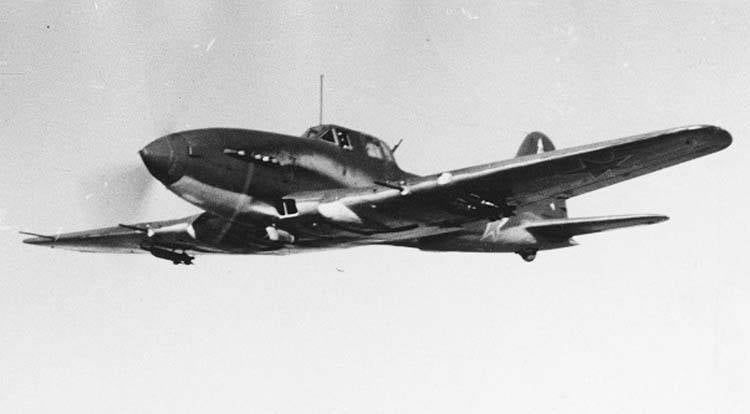
But even not improved aerodynamics, in my opinion, has become a more useful alteration. The design of the IL-10 was finally thought out and (most important) the protection of the shooter was correctly implemented. I will not compare with the IL-2, everything was done there according to the principle “I blinded it from what it was”, the defense seemed to have a place, but the arrows died like flies. On the IL-10, everything was done initially. And the experience of using IL-2, and the death of a huge number of shooters played a role.
From bullets and shells from the back of the hemisphere, the arrow was protected by an armored partition formed by two adjacent armor plates 8 mm thick each with a gap between them. This protection successfully withstood shells of 20 mm cannons. Ours, ShVAK, which were more efficient than the German.
By the way, the pilot was protected in the same way, he was protected by an armored wall and a headrest, which were two armor plates 8 mm thick.
There was, of course, the probability for the shooter to get hit in the open part, but alas, there was nothing to be done about it.
Moving on.
In the front windows of the pilot's lantern, transparent armor 64 mm thick with a metal edging was placed. Transparent armor was carried out in two layers: raw silicate glass was glued to a plexiglass base. The hinged side covers of the cockpit lantern were made of metal armor (6 mm thick) and plexiglass. Above, the pilot's head was covered with 6 mm armor mounted on the lantern.
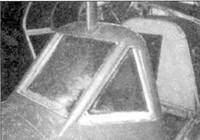
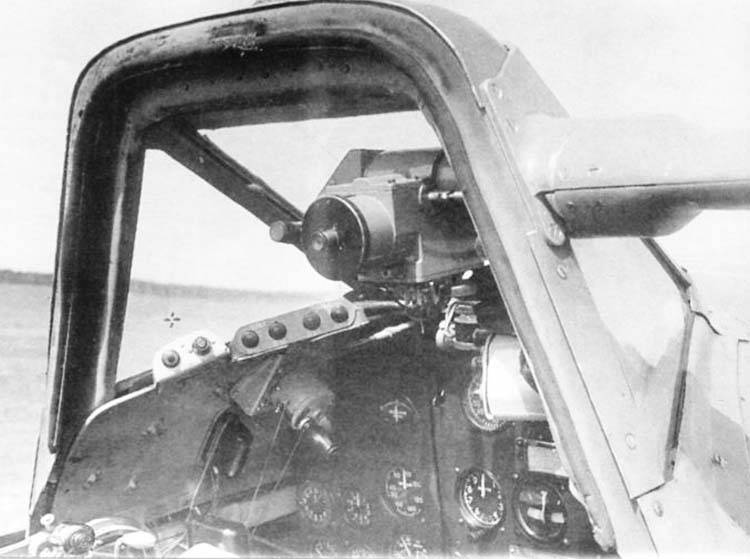
Separate opening of the lid covers allowed the pilot to get out of the cockpit with a full hood of the aircraft. On the side of the lantern there were movable vents.
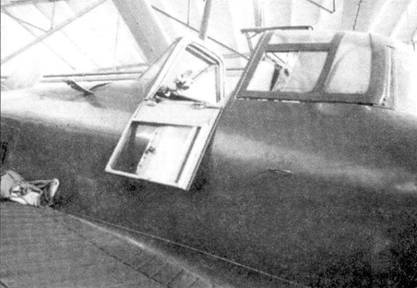
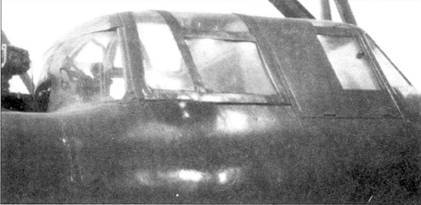
There were places where the armor was reduced. For example, the thickness of the side walls of the cockpit and arrow is reduced to 4 and 5 mm, and the lower part and the floor of the cockpit arrow to 6 mm. Also, the thickness of the hoods armor on top was reduced (to 4 mm), and the lower side ones, on the contrary, increased from 6 to 8 mm.
This is already according to the results of the analysis of damage to IL-2. As the experience of its combat use showed, the front upper part of the aircraft was practically not affected in aerial combat - it was unattainable for fire from the ground, the shooter defended it from the fighter’s fire, and German pilots generally preferred not to mess with the IL-2 in front, evaluating the damaging factor of the VYA-23 cannon shells.
The authors of the IL-10 armor improvement should be mentioned and once again thank them. These are the specialists of NII-48, led by the director of the institute, Professor Zavyalov.
The shape of the new Il-10 armored hull made it possible to improve engine cooling due to the new arrangement of water and oil radiators for the engine cooling and lubrication systems, which were now fully housed in the armored hull behind the center wing side member under the cockpit floor. Air was supplied through the tunnels on the sides of the motor. The temperature could be adjusted using the bronze shutters (5-6 mm thick) from the cockpit.
From below, the tunnels were covered with 6 mm armor, and on the sides with a 4 mm armored hull. From the rear side member, the tunnels were covered with 8 mm thick armor.
Thanks to this layout solution, the contours of the armored hull were made smoother than the Il-2, and the more aerodynamically advantageous scheme for blowing radiators made it possible to reduce their size and resistance.
The total weight of the armor of the Il-10 production aircraft (without fastening) was 914 kg.
The weapon control system was redone. The guns and machine guns were controlled using an electric button on the aircraft control stick and two switches on the shield in the cockpit.
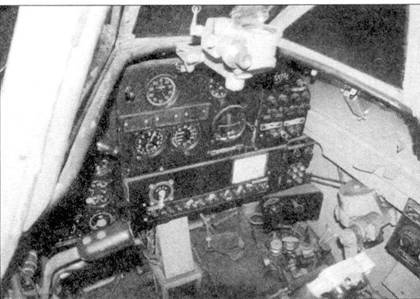
When shooting, it was necessary to first turn on the tumbler of machine guns or cannons, and then to fire by pressing the combat button placed on the control handle. When you turn on both toggle switches, fire was fired from all trunks at once. The machine guns still had a separate descent using a cable.
The reload was pneumatic, controlled by four buttons on the pilot panel.

I’m duplicating the photo, but just here four reload buttons and two weapon selector switches to the left of the sight are clearly visible.
On the attack aircraft was provided (but not necessarily mounted) the installation of 4 beams (two for each console) for rockets of three types: RS-132, ROFS-132 and RS-82.
In addition to bombs, suspension of poured chemical devices UHAP-250 was originally planned for external bomb racks. By 250, the UHAP-1943 was not at all planned to be used as a device for spraying poisonous substances, but it proved to be excellent as a device for setting smoke screens.
Unlike the IL-2, the IL-10 made two bomb compartments instead of four. In the bomb bay of IL-10 with normal bomb load was placed:
- PTAB-2,5-1,5 - 144 pcs. / 230 kg by weight;
- AO-2,5sch (steel cast iron) - 136 pcs. / 400 kg;
- AO-2,5-2 (bomb from a 45-mm shell) - 182 pcs. / 400 kg;
- AO-8M4 - 56 pcs. / 400 kg;
- AO-10sch - 40 pcs. / 392 kg;
- АЖ-2 (chemical ampoule) - 166 pcs. / 230 kg.
Bombs from 100 to 250 kg were hung on locks located on the center section.
Air bombs were dropped and the smoke curtain was set electrically using the battle button located on the aircraft control handle, the ESBR-ZP electric bomber, mounted on the right side of the cockpit, and the temporary VMSh-10 attack mechanism located on the right side of the instrument panel.
On the attack aircraft there was an alarm of suspended bombs on the external locks DER-21 and DZ-42, as well as the open position of the flaps of the bomb bay and the drop of small bombs. In this case, the signal lamps responsible for the bombs on the DER-21 and DZ-42 in the working position (that is, when the bomb is suspended) burned and went out as the aircraft was released from the bombs. The signal lights of the hatch leaves, on the contrary, only light up when the hatches are open.
In the rear part of the fuselage mounted a holder of aircraft grenades DAG-10. 10 grenades AG-2 were placed in the holder.
The only thing that remains at the level of the beginning of the century is sights. Aiming during bombing was carried out using sighting lines and pins on the hood and crosshairs on the front glass of the lamp.
Since October 1944, the first serial IL-10 production plants No. 1 and No. 18 without preliminary control tests at the Civil Aviation Research Institute of the Air Force KA began to be transferred to military acceptance for the rearmament of combat units. By January 5, 1945, the 1th IL-45 entered the 10st spare air brigade for the rearmament of marching regiments.
The 10th guards assault aviation orders of the Suvorov and Bogdan Khmelnitsky regiments of the 108rd assault air division (commander lieutenant colonel O.V. Topilin) became the first regiment in the air force to use the IL-3 attack aircraft. The regiment received planes directly at the factory number 18 in Kuibyshev.
In the process of retraining the flight personnel of the regiment and testing the flight test program for serial vehicles, a number of serious design and manufacturing defects were identified both for the aircraft itself and for the AM-42 engine.
Cases of aircraft fire in the air and even the death of a pilot (captain Ivanov) during a training flight were recorded.
It must be said that neither on the IL-10 plane, which was tested at the Civil Aviation Research Institute of the Air Force, nor on the machines circled by the test pilot of the 18th plant KK Rykov, fires never occurred.
A state commission arrived from Moscow to investigate the incident. As a result of her work, a decision was made to temporarily suspend the serial production of IL-10. In December 1944, production was resumed. Deficiencies have been eliminated.
The fighting of the 108th gshap began on April 16, 1945 in the Berlin direction. During the 15 days of fighting (from April 16 to 30), pilots of the 108th gshap made 450 sorties, in which the study of the capabilities of the attack aircraft continued.
The conclusions of the report on the results of military tests of the IL-10 aircraft indicated that:
- The bomb load of the aircraft by weight, purpose and caliber of the suspended bombs ensures the fulfillment of the tasks assigned to the attack aircraft.
- The armament of the IL-10 aircraft in terms of the number of combat points, caliber and ammunition for them does not differ from the weapons of the IL-2.
- When acting on targets covered by enemy fighters, an IL-10 requires escort to the same extent as an Il-2. The presence of a larger range of speeds and better maneuverability facilitates the task of escort fighters and allows the IL-10 to engage in active air combat with the enemy.
- The survivability of the structure (booking the crew and the propeller group) is better than on an IL-2 aircraft, and in general is sufficient. Vulnerabilities can be water and oil radiators. In general, the effectiveness of the armor protection of the crew and the Naval Aviation Defense against small-caliber anti-aircraft artillery and fighter aircraft during the military tests has not been sufficiently identified and require additional verification by analyzing damage to aircraft located in other active parts of the Air Force.
- The view from the cockpit, due to the lack of back view and shading of the front glass in bad weather conditions (rain, snow), is worse compared to the view on the Il-2 airplane.
The main method of bombing in combat conditions on an IL-10 airplane is the same as for the IL-2, with the only difference being:
- Planning angles increased from 30 to 50 degrees;
- increased the speed of entry into the dive from 320 to 350 km / h;
- the speed of withdrawal from the dive increased to 500-600 km / h;
- improved aircraft maneuverability.
In addition, it was noted that the aircraft is simple in piloting techniques. Having better stability, good handling and higher maneuverability, the IL-10 in comparison with the IL-2 eagerly forgives the flight crew for errors and does not tire the pilot when flying in a dummy.
Retraining of the flight and engineering personnel who worked on the IL-2 with AM-38f, when switching to the IL-10 with AM-42, is not difficult. Flight crews need 10-15 training flights with a total flight time of 3-4 hours. The engineering staff can easily master and study the materiel of the aircraft and engine directly during operation.
But there were also negative points. The State Commission noted the following as the main defects of the IL-10.
- Poor lamp design of the cabin (it is difficult to open on the ground, taxiing and flight in difficult weather conditions with an open lamp are impossible).
- There is no review back from the cockpit (it is necessary to make an insert from transparent bulletproof glass in the armored back like an Il-2 aircraft).
- The efforts on the handle of the wheels of the chassis during taxiing and landing on soft ground and in winter burrow into the snow, deform and slow down the movement of the aircraft.
- Ropes everywhere are torn: both restrictive cables of a lamp of a cabin and emergency release of the chassis, and control systems, and also cables of a stopper of a crutch.
- The strength of the tires of the wheels 800x260 mm, as well as the effectiveness of the brakes, is insufficient.
- In case of emergency landing, the power frame of the chassis unit breaks down and the tail wheel stops collapse when landing with the crutch removed, and the frame No.14 of the fuselage breaks.
- The landing gear at an air pressure in the system of 38 atm. at speeds over 260 km / h are not available.
- Insufficient reliability of the AM-42 motor and its short service life.
- Lack of air filters in the air intake system in the motor dust filter.
In conclusion of the report on military tests, the state commission concluded that the IL-10 AM-42 satisfactorily passed the military tests and is a completely modern armored attack aircraft of the KVS.
During military trials, pilots of the 108th infantry regiment destroyed and damaged 6 units of armored vehicles, 60 vehicles, 100 enemy wagons with cargo.
So, on April 18, the 12th Il-10 (the leading commander, Mr. Pyalipets), accompanied by 4 La-5s, launched a bombing assault on enemy vehicles and tanks in the vicinity of Gross-Osning, the Cottbus-Spremberg road.
In five approaches, the group destroyed and damaged up to 14 vehicles, one gun and a tank.
On April 20, the IL-10 seven (presenter - navigator of the regiment, Mr. Zhigarin) launched a bombing attack on suitable enemy reserves on the roads Grosskeris-Troinitz, Erodorf-Tophin. Finding a large convoy of German tanks and vehicles covered by anti-aircraft artillery, the group quickly suppressed anti-aircraft gun fire, and then set fire to 12 vehicles and one tank in 15 approaches.
On April 30, the regiment suffered the first loss. When moving away from the target of a group of attack aircraft Zheleznyakov’s comedian, a large-caliber anti-aircraft shell hit the 10th pilot of Gorodetsky ... The crew died.
An analysis of the combat capabilities of the IL-10 attack aircraft shows that the effectiveness of the IL-10 during operations on German medium tanks, compared with the IL-2, has increased significantly, despite the reduced bomb loading with anti-tank aerial bombs and chemical ampoules. However, piloting and aiming in this case required increased attention from the pilots and were beyond the power of young pilots. But for an experienced and trained attack pilot, the IL-10 was a more effective weapon.
However, if we analyze the qualitative composition of the German tank forces at the final stage of the war, we have to admit: the adoption of the Il-10 attack aircraft did not adequately increase the anti-tank properties of the Red Army attack aircraft. The power of 23 mm guns to defeat the medium tanks of the Wehrmacht was clearly not enough.
The final phase of the war with Germany can be called a testing ground for the IL-10. Then there was the war with Japan, in which the 26th cap of the 12th combat unit of the Pacific Fleet took part. It was the only assault air regiment as part of the Air Force KA and Navy group in the Far East (9th, 10th and 12th VA, Pacific Fleet Air Force), armed with IL-10.
Mostly aircraft attacked ships and vehicles and worked to suppress enemy anti-aircraft points. It turned out that Japanese 25-mm anti-aircraft guns pose a real danger to attack aircraft.
On July 9, 1945, regiment attack aircraft attacked ships in the port of Racine. According to aircraft crews, one transport was sunk, one was damaged.
The Japanese shot down 2 IL-10 directly during the attack and two were damaged so that the planes crashed before they reached the airfield at sea. During the second strike on the same day, another IL-10 was shot down.
Such a large loss of attack aircraft came as a complete surprise to the Soviet command.
A superficial analysis of the past battles shows that, using standard methods of attacking ground targets with a diving angle of 25-30 degrees, the IL-10 attack aircraft had virtually no obvious advantages over the less speedy and less maneuverable IL-2.
Unfortunately, the attack pilots, due to insufficient training, did not use all the capabilities of the new attack aircraft (diving from dives at angles of 45-50 degrees), which could significantly reduce the accuracy of the Japanese anti-aircraft gunners, while ensuring high accuracy of bombing and firing.
Since August 1945, a VU-10 mobile unit with a B-9T-E gun, which successfully passed state tests at the Air Force Research Institute, began to be installed on serial IL-20s.
In just 5 years of serial production, three aircraft plants (No. 1, No. 18 and No. 64) produced 4600 combat IL-10s and 280 training IL-10Us.
In general, the operation of the aircraft was very much hampered by the quality of the AM-42 motor. Numerous failures were noted, caused by both unsatisfactory service in parts and defective production in factories. But all the time the service of IL-10 was accompanied by constant failures and aircraft accidents.
IL-10 was in service not only in the USSR, but also in the socialist countries. In 1949, 40 IL-10s were received by the Polish Air Force (4th, 5th and 6th assault regiments). In addition, the IL-10 entered service with the Yugoslav and Czech Air Force.
Since the end of December 1951 in Czechoslovakia, at the Avia aircraft plant in Sokowice, the serial production of the licensed version of the Il-64 under the designation B-10 was launched according to the drawings of the Voronezh aircraft plant No. 33.
On its basis, the Czechs also produced a training version of the SV-33. In the period 1953-54. Czech attack aircraft were delivered to Poland, Hungary, Romania and Bulgaria.
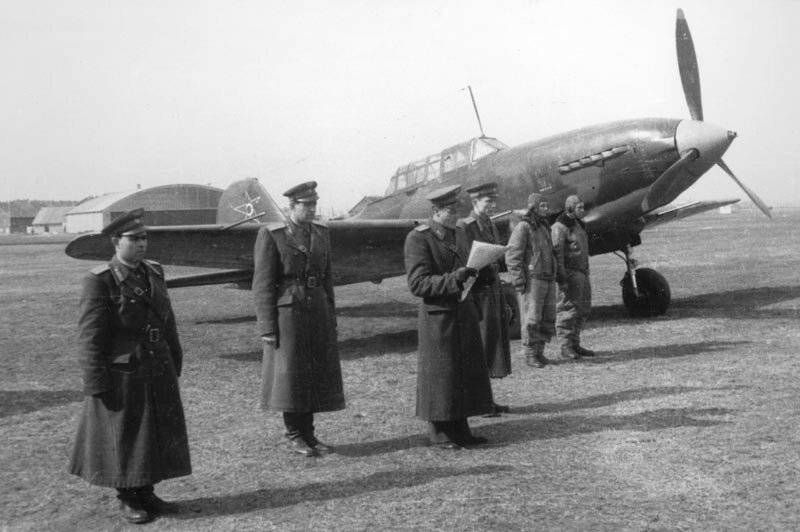
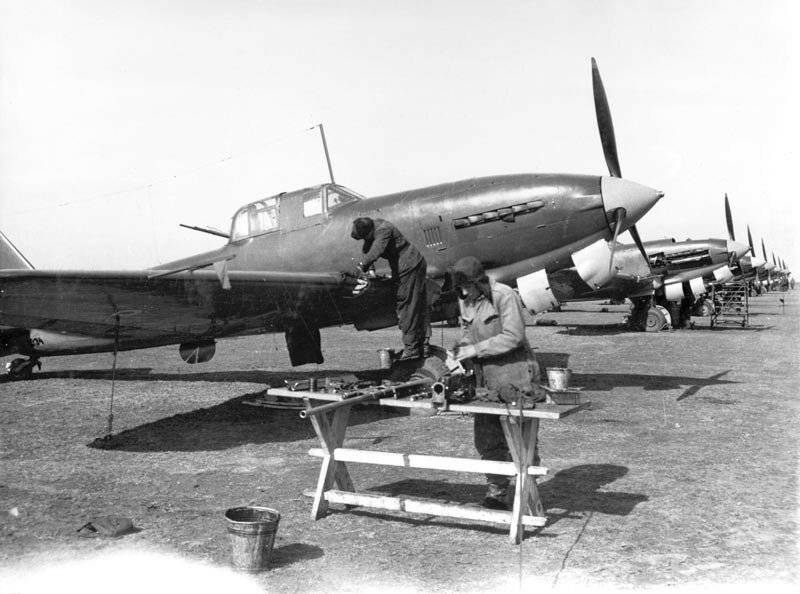
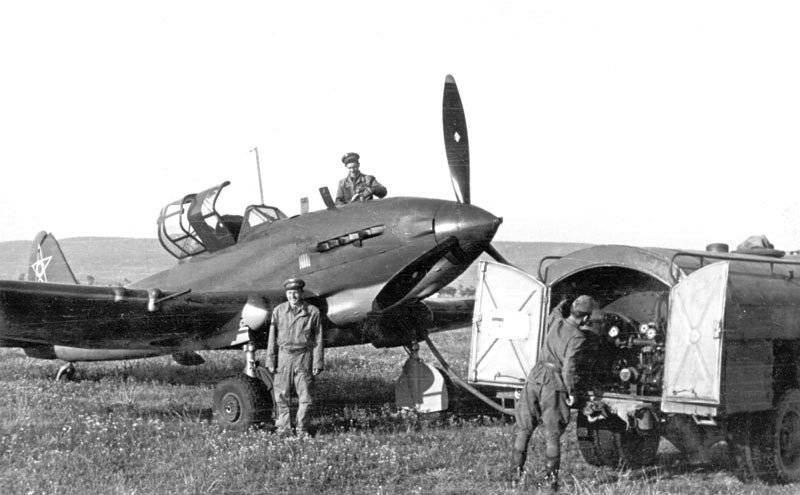
Serial production of the B-33 was completed in 1955 after the release of 1200 aircraft of this type.
Unlike the Soviet IL-10, Czech attack aircraft were armed with 4 NS-23RM cannons (150 shells per barrel).
The third and last war for the IL-10 was the war in Korea, where it was used by the Korean Air Force, and as an attack aircraft was very effective.
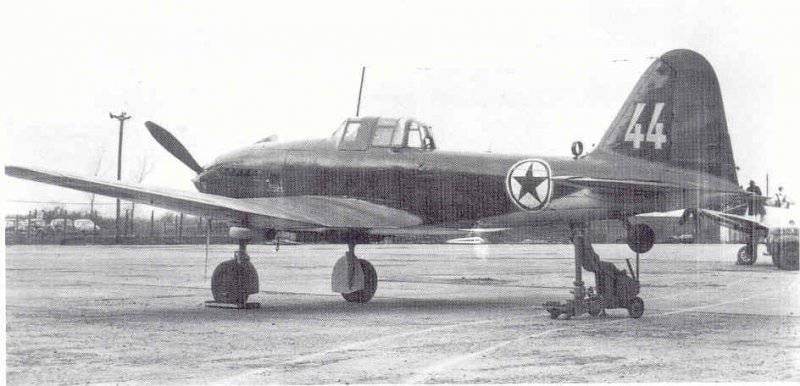
But the heavy losses from the actions of jet fighters actually blew up the assault units of North Korea, and out of 90 aircraft by the end of the war no more than 20 remained.
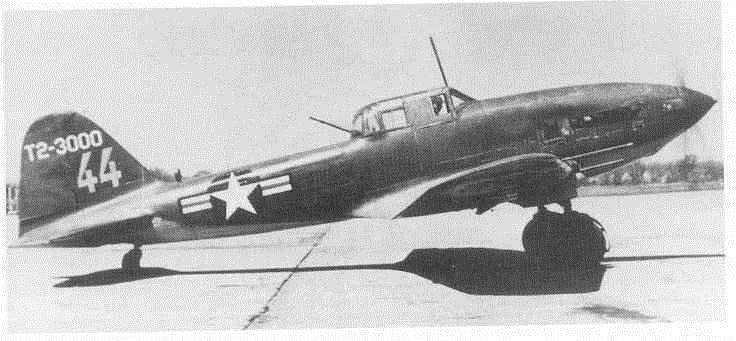
US trophy at US Air Force Test Center
So how can you call IL-10: modernization of IL-2, or is it still a new aircraft?
If we go by analogy with a pair of LaGG-3 / La-5, then still the IL-10 was a different machine. You can use the words "deep modernization", but do not want to. A complete alteration of the armored hull, electrification of control, another wing, improved aerodynamics - everything suggests that it was a very painstaking work, taking into account all the identified shortcomings of the IL-2.
And the plane turned out very good. It was spoiled only by the frankly capricious and unreliable AM-42 motor, but engine building has never been our strong point. So do not be surprised.
How not to be indignant that the IL-10 so quickly left the race. The reason for this was not even the AM-42, but the jet engines that had conquered the sky.
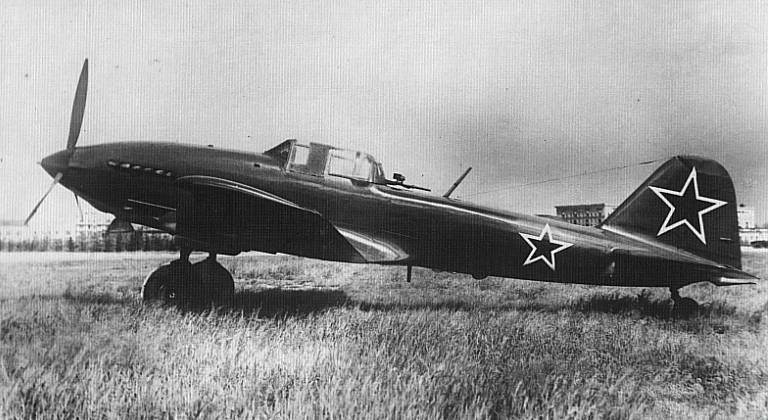
But in general, it was an attack aircraft, to which I would like to apply such an epithet as "literate". Indeed, the plane was not something so outstanding, or, as it is customary to broadcast today, “having no analogues in the world.” It was a competent work of people who perfectly understood what and why they were doing.
LTH IL-10
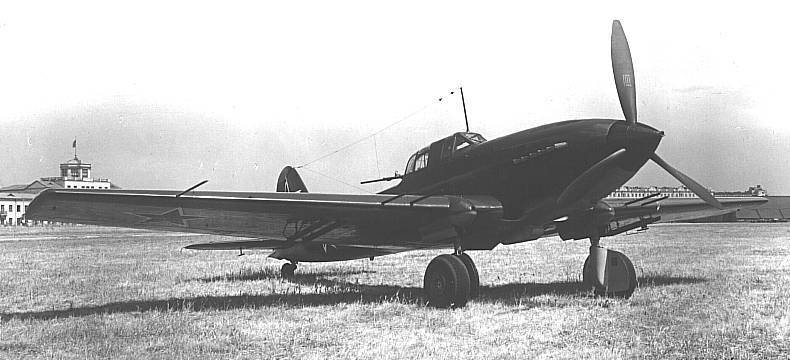
Wingspan, m: 13,40.
Length, m: 11,12.
Height, m: 4,18.
Wing Area, m2: 30,00.
Weight, kg:
- empty aircraft: 4 650;
- normal takeoff: 6 300.
Engine: 1 x Mikulin AM-42 x 1750 hp
Maximum speed km / h:
- near the ground: 507;
- at height: 551.
Cruising speed, km / h: 436.
Practical range, km: 800.
Rate of climb, m / min: 625.
Practical ceiling, m: 7 250.
Crew, person: 2.
Armament:
- two 23-mm guns VYA-23 or NS-23;
- two 7,62-mm ShKAS machine guns;
- one 20-mm UB-20 (Sh-20) gun or 12,7-mm UBS machine gun for protecting the rear hemisphere;
- up to 8 RS-82 or RS-132.
Bomb load:
- the normal version is 400 kg (2 FAB-100 in the bomb bay and 2 FAB-100 on external suspensions);
- reloading - 600 kg (2 FAB-50 in compartments and 2 FAB-250 on external suspensions).
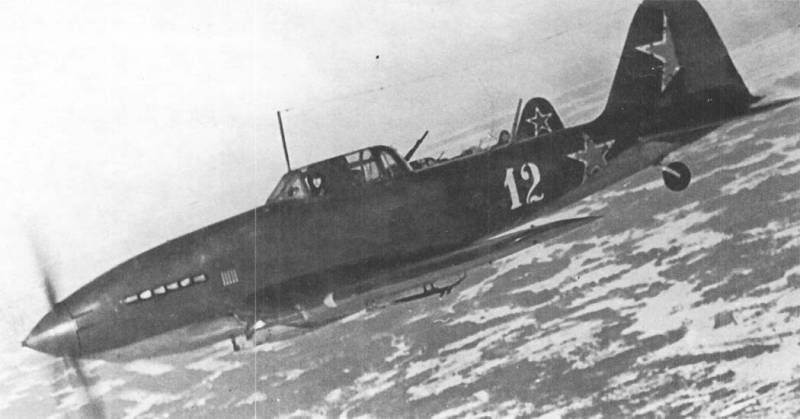
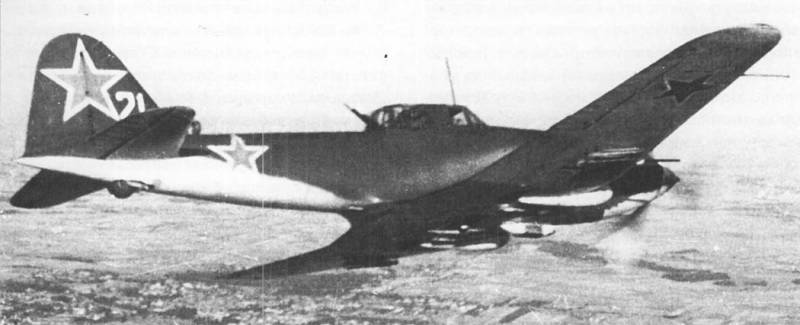
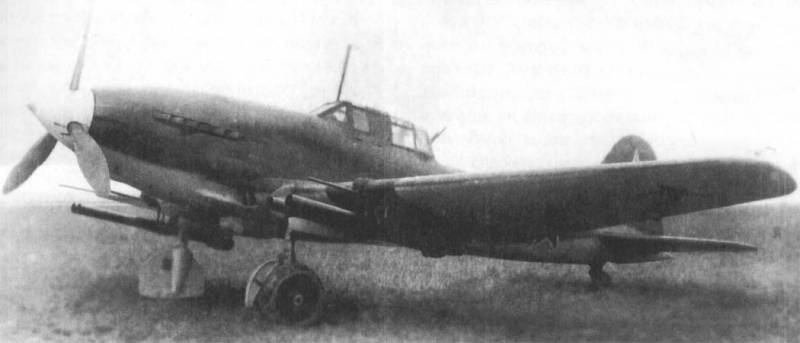
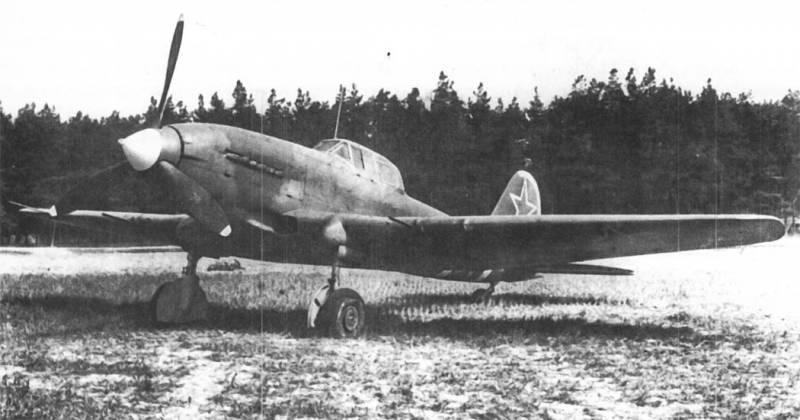
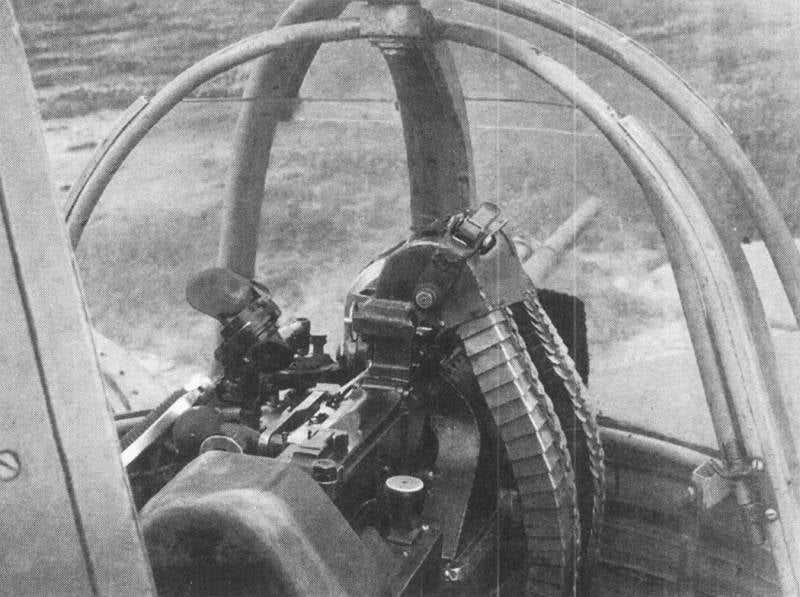
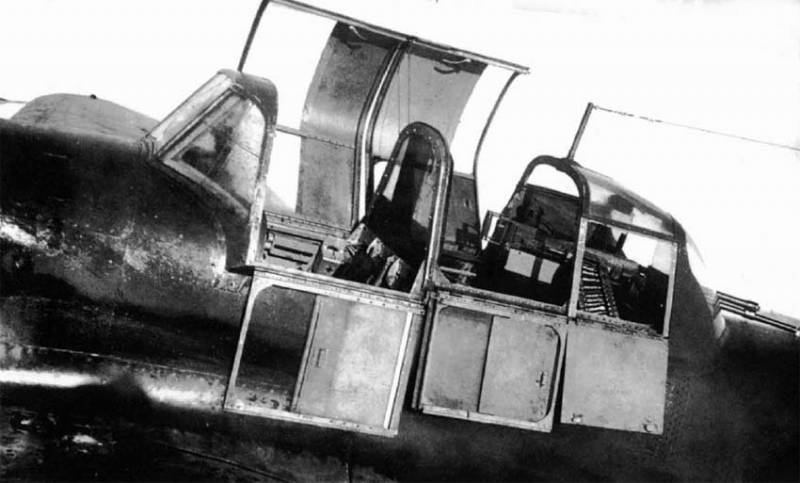
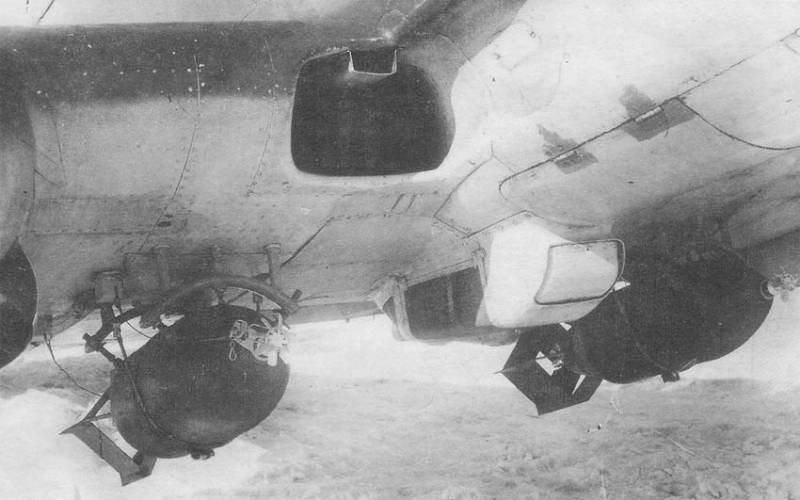
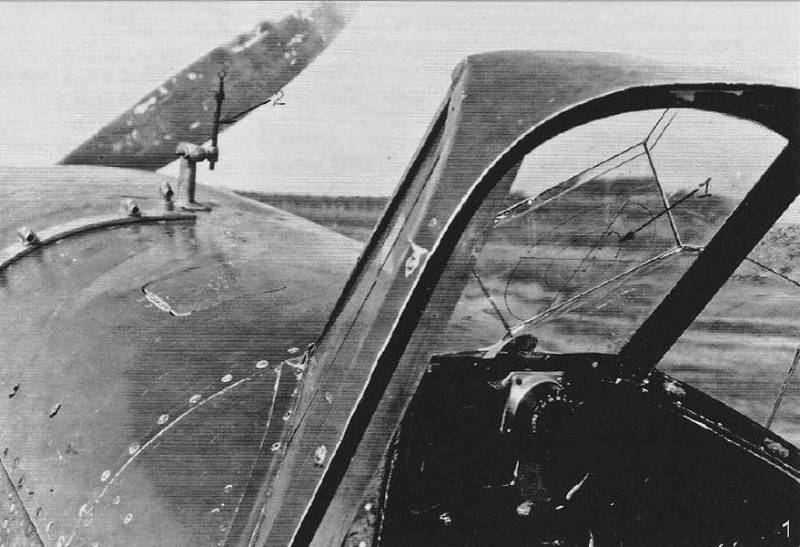
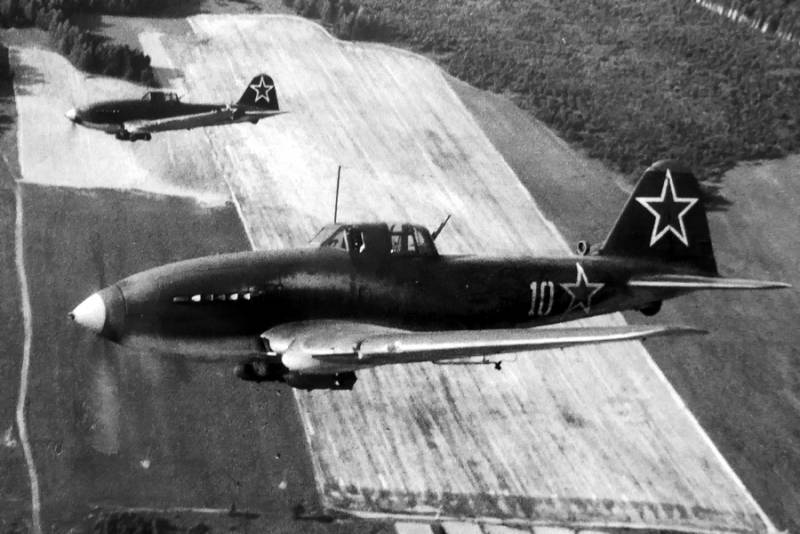
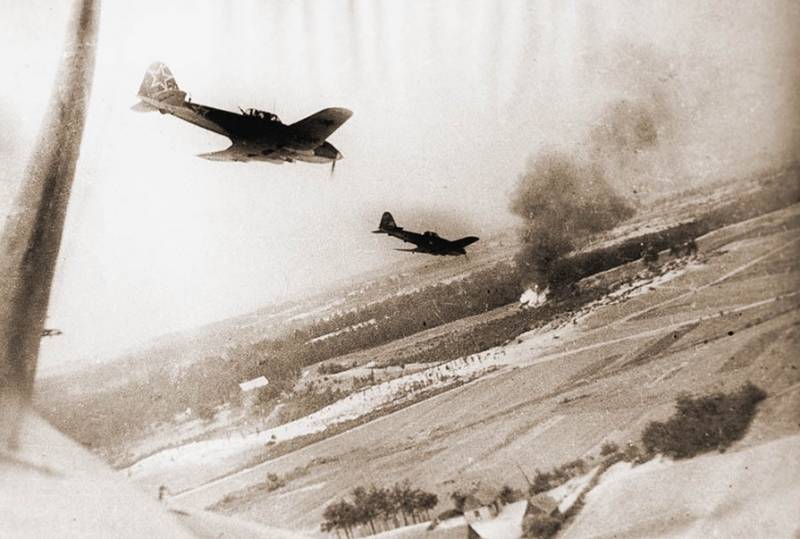
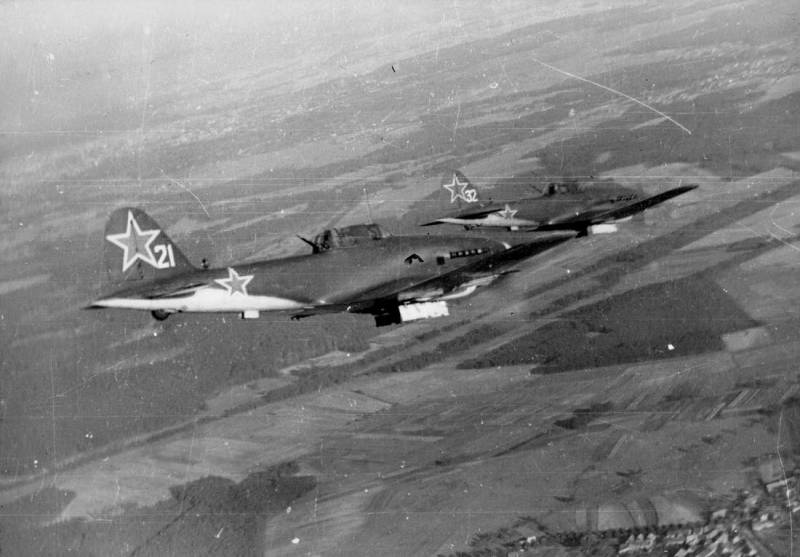
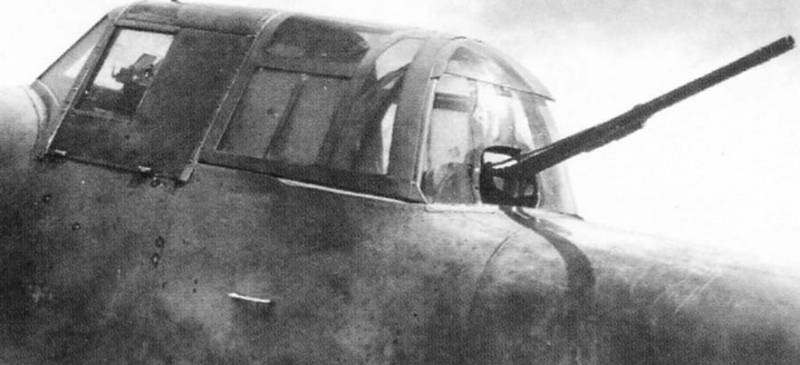
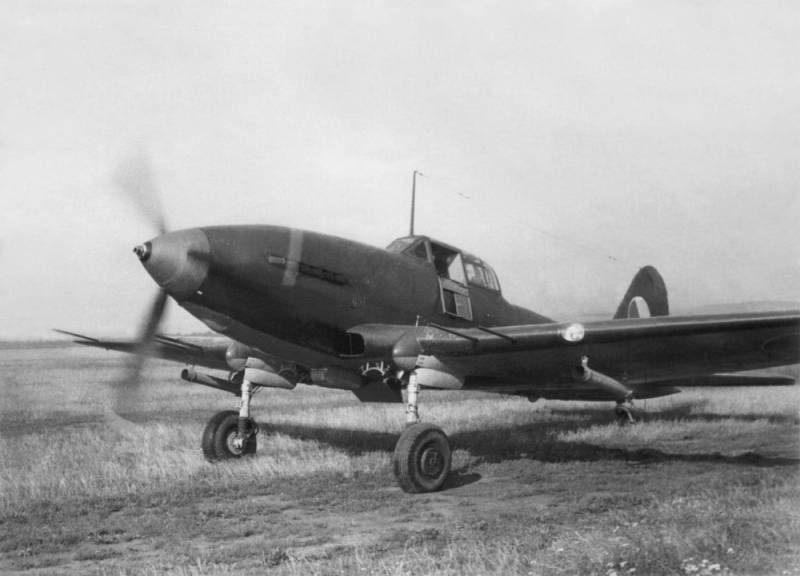
Information